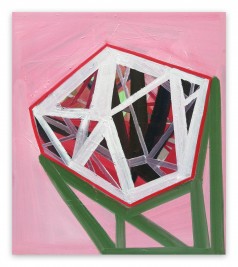A line is said to connect two points. It is a one-dimensional visual element. But what else can a line be? When does a line become a plane? When does a line become a shape? When does a line obtain mass and become a form? Can a line also be a color? Can it be a symbol? What can line tell us about gesture? Lines can provide a sense of visual architecture, endowing a visual composition with structure and harmony. Lines can also suggest energy and emotion. They can signal chaos as quickly as they can inspire calm.
When we say that an artwork is linear, we may be talking about the actual lines, or we may be talking about a general sense that the composition is horizontal or vertical in nature—we may be talking about stripes or other linear patterns. Pierre Auville mobilizes line as form, line as surface, line as texture, and line as structure. Audrey Barcio employs line as a template, to define angles, and to create space. Ashlynn Browning and Susan Cantrick use line to explore depth and create mass. For Daniel Göttin and Brent Hallard line is concrete. Whatever its purpose, meaning, or method, line is an essential aspect of visual abstraction.
Untitled 10
Claude Tétot
Line and Structure 11
Dana Gordon
Untitled 1 2001
Daniel Göttin
The Effects of a fold on a pink line
Debra Ramsay
Bulge 14
Holly Miller
Maelstrom Series 77
Jaanika Peerna
Long Color Stack 1
Jessica Snow
Tempo
Kim Uchiyama
Drybrush with Building
Laura Newman
Intersect # 201801
Paul Snell
Untitled (257.11)
Tilman
Untitled (15), 2013
Richard Caldicott
Pedestal
Ashlynn Browning
Deep Horizon













